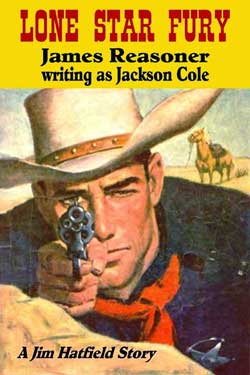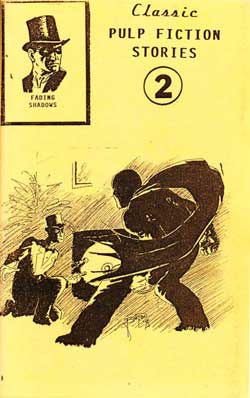 I have been reading James Reasoner Westerns since long before I knew I was reading James Reasoner Westerns. A prolific and in-demand author since the 1970s, he has written under a number of pseudonyms and house-names for series titles including the Trailsman (as Jon Sharpe) and Longarm (as Tabor Evans). He’s also adept at crime fiction and adventure—he penned Hard Case Crime’s debut Gabriel Hunt novel, Hunt at the Well of Eternity—but this Spur Award nominee, with 200 or more books to his name, is widely revered for his Western tales like “Lone Star Fury,” where he is writing as Jackson Cole. This story actually heralds from earlier in the author’s career—going back near twenty years when it was originally published in Classic Pulp Fiction Stories (No. 2, July, 1995)—and is fortunately available again as an ebook.
I have been reading James Reasoner Westerns since long before I knew I was reading James Reasoner Westerns. A prolific and in-demand author since the 1970s, he has written under a number of pseudonyms and house-names for series titles including the Trailsman (as Jon Sharpe) and Longarm (as Tabor Evans). He’s also adept at crime fiction and adventure—he penned Hard Case Crime’s debut Gabriel Hunt novel, Hunt at the Well of Eternity—but this Spur Award nominee, with 200 or more books to his name, is widely revered for his Western tales like “Lone Star Fury,” where he is writing as Jackson Cole. This story actually heralds from earlier in the author’s career—going back near twenty years when it was originally published in Classic Pulp Fiction Stories (No. 2, July, 1995)—and is fortunately available again as an ebook.
Two men waited in the stygian shadows of the alley, cocked revolvers in their hands. Across the broad, dusty, tumbleweed-littered street, two more men stood in similar concealment, guns in hand, murder in their hearts.
Into this cauldron of death in the ghost town of Palminter rides Texas Ranger Jim Hatfield, sometimes referred to as the Lone Wolf. What brought him to this desolate, and deadly, locale in the western part of Texas? A message seemingly from the great beyond: a former flame named Sally Conway, whom Hatfield believed had died five years before in a horse accident, sends for his help.

That path leads him, and his faithful golden sorrel, south and eventually along the Rio Grande to the once notorious Mesa City. The denizens had settled down into a proper community, but, again, it’s in danger of becoming a hell town thanks to the opportunist desperadoes infesting the region. Hatfield finds Sally very much among the living near Mesa City and married to a wealthy rancher named Ben Jardine, and the two men instantly detest one other. Hatfield also learns Sally is being treated by a doctor who has been caring for her since the accident. The sawbones explains she’s in a fragile state, requiring constant care and medicine or else she tends to see things that are not really there. But the ranger isn’t buying it. Something is amiss with his onetime sweetheart and Jardine, and Hatfield is determined to get to the bottom of Sally’s visions and the marauding owlhoots who are plaguing Mesa City. Naturally, this will bring him face to face with some rough-and-tumble renegades:
Hatfield’s fingers closed on Deke’s wrist like a vise as the outlaw tried to bring the Colt to bear. The Ranger’s other hand locked on Deke’s throat, and the two men did a desperate dance of death on the terrace, Deke struggling for breath, Hatfield trying to keep the barrel of the gun from pointing at him.
A generous helping of robust action rounds out this swift-moving, 7K word novelette but also some old-fashioned moral shrewdness that you would expect from a white hat like the Lone Wolf (whose adventures stretch to the 1930s golden era of pulp) factors in. Think Have Gun Will Travel’s Paladin with his code of honor mixed with Wanted: Dead or Alive’s volatile action.
Mr. Reasoner has been writing Westerns since Gunsmoke was a weekly staple, and in all these years his storytelling abilities haven’t diminished one iota, with recent highpoints including Outlaw Ranger, Hangman’s Knot, and Last Stagecoach to Hell.
Never read the sage from Texas? Then you have a lot of catching up to do, pilgrim. And Lone Star Fury is as good of a place to swing up into that saddle as any. For his many loyal fans, this tale is another reason why we return again and again to Mr. Reasoner’s appealing storytelling.
Edward A. Grainger aka David Cranmer is the editor/publisher of the BEAT to a PULP webzine and books and the recent Western novella, Hell Town Shootout.
Read all of Edward A. Grainger's posts for Criminal Element.

Randy Johnson here,
I enjoyed this one also. Read a great deal of James’ work, but hardly put a dent in the backlog. Probably never catch up, though it will be fun raeding trying.
Oh, I’m with you, Randy. Yeah, not even close to making a dent in that excellent body of work.
Sounds like my kind of reading!
I’m sure it is, Oscar.
I’ve read and enjoyed a lot of Reasoner westerns, and a lot of Jim Hatfield stories, but didn’t know the twain had met. This is great news. According to one source, about half of the 206 Hatfield pulp adventures by “Jackson Cole” were written by series creator Alexander Leslie Scott. Wish I knew who wrote the rest.
Evan, this link ( http://fr.wikipedia.org/wiki/Alexander_Leslie_Scott ) from the sometimes reliable Wikipedia (have to translate page) says that Scott’s son, Justin Scott, is still alive. Bet he would have most of that history.
Justin Scott is not only alive, he’s writing books for Clive Cussler these days. Nearly all of the Jim Hatfield stories in TEXAS RANGERS have had their actual authors identified. Leslie Scott and Tom Curry each wrote 55 Hatfield novels. I don’t remember the exact numbers on the other authors, but Scott and Curry did the most. Walker A. Tompkins and Peter Germano (better known under the pseudonym Barry Cord) were both significant contributors to the series, Tompkins from the mid-Forties on until the pulp ended in 1958 (he wrote the last novel published) and Germano in the Fifties. Roe Richmond wrote about a dozen Hatfield novels in the Fifties, which he later expanded and sold under his own name, with Hatfield changed to a Ranger named Lash Lashtrow. Other authors who wrote Hatfield novels were Gunnison Steele (real name Bennie Gardner), J. Edward Leithead, Dean Owen (Dudley Dean McGaughey), D.B. Newton, Joseph Chadwick, Samuel Mines, C. William Harrison, Clark Gray, Lin Searles, and probably one or two others I’m forgetting. Luckily most of these authors had fairly distinctive styles, so it’s not too difficult to tell who wrote what, although a few novels are still unattributed as far as I know.
Thanks James. Looks like the same crew who wrote the other Thrilling series, Rio Kid, Masked Rider and Range Riders, where they got to use their own names (or pen names).
Thank you so much for the revealing history, James. I’m always at a loss of how much I’ve missed. And many of those writers are very familiar to me and now ( http://www.justinscott-paulgarrison.com/justinscott.html ) Mr. Scott as well.
David, Mr. Reasoner’s storytelling is definitely “appealing” though I have only read his crime fiction. I’m looking forward to treating myself to his westerns in coming months. It was interesting to read his comment on the authorship of the Jim Hatfield stories.
Prashant, James Reasoner has written a lot of tremendous crime fiction. I do have my preference for the Westerns but that’s only because that genre is my first love. He’s written some outstanding alternate history, sci-fi, and horror as well.
Excellent post, David. There are gaping holes in my knowledge of Western fiction, so I appreciate being led in the direction of some good titles of that kind. You haven’t failed me yet and I’ll try this one soon.
Thank you, Brian. Glad to be of help. Just repaying you for numerous noir and crime articles that have altered my reading habits.